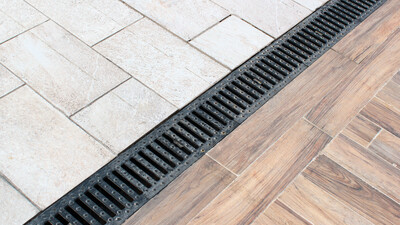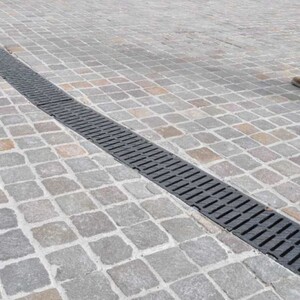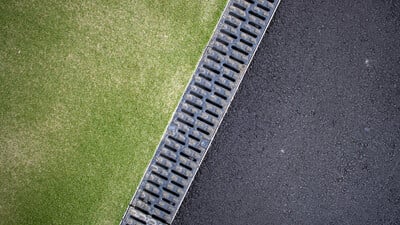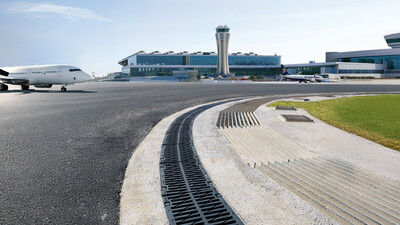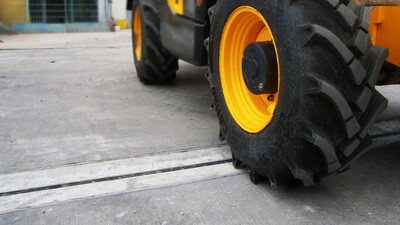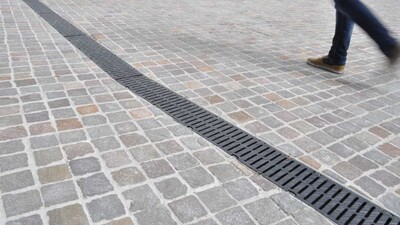
Our Channel Drainage Solutions
Channel drains are used to remove surface water from non-permeable areas such as roads and driveways, car parks, plazas and flat roofs. This is vital as these areas can pose numerous risks if water pools and accumulates over time. Without channel drainage you risk committing numerous health and safety violations, along with creating an unsafe environment for vehicles and pedestrians.
These solutions are also used in situations such as car washes, food processing and chemical plants to capture spillages and prevent them from contaminating the soil or watercourses. Drainage channels can limit environmental impact from uncontrolled surface run-off by directing it to the necessary treatment systems and discharge points.
At Drainfast, we stock a wide range of channel drains in sizes and load ratings tailored to meet any requirement and location, while supporting effective water management on-site. We also provide drainage solutions below the surface, with underground drainage built to support consistent drainage and long-lasting system integrity.
Why Choose Drainfast?
With over two decades of experience, Drainfast is one of the UK’s most trusted suppliers of channel drainage. We stock solutions suitable for all environments, available in all six BS EN 124:2015 load classes to help reduce flood risk and support effective water management. Our expert team is always on hand to guide you to the right product based on your site and application. Every channel drain we supply is made from durable, low-maintenance materials—built for strength, reliability and long-term performance. Take advantage of our free take-off service, fast in-house delivery fleet and the confidence that comes from working with a team that truly understands groundworks.
How To Choose The Right Channel Drain
To ensure the correct product is used for the application, all channel drains are given a load rating, with six standardised load ratings set by BS EN 124:2015 covering all requirements.
Class A15 channel drain
With a maximum weight load of 1.5 tonnes, this is suitable for very light-duty applications such as gardens and patios.
Class B125 channel drain
This channel drain has a maximum weight load of 12.5 tonnes, making it suitable for domestic driveways where only cars and vans will be used.
Class C250 channel drain
Light-traffic roads and private car parks are most likely to use this channel drain, which has a maximum weight load of 25 tonnes. However, if HGV delivery vehicles and dust carts will be accessing these areas, a heavier-duty channel drain will be required.
Class D400 channel drain
High-traffic areas such as public car parks, main roads and motorways will require this channel drain’s 40-tonne maximum weight load.
Class E600 channel drain
The additional weight of forklift trucks and other materials handling equipment means that this channel drain, with a maximum weight load of 60 tonnes, is commonly used on industrial estates, loading bays and cargo handling yards.
Class F900 channel drain
Areas of extremely heavy-duty operations such as airports and docks will require the 90-tonne maximum weight load of this channel drain.
Bear in mind, however, that there might be occasions where a channel drain will be subjected to additional loading. For example, a private car park might be used by a medium-sized commercial vehicle such as a dustcart or removals lorry, which will need a heavier D400 load class channel drain. If in doubt, it’s a good idea to choose a channel drain with a higher load rating and prevent a collapse.
Channel Drains FAQs
What is Channel Drainage?
Channel drainage is a solution used for managing surface water in paved areas susceptible to flooding. The pre-formed U-shaped trough features protective grating and sits flush with the ground surface to efficiently manage surface water run-off by diverting it to locations such as stormwater drains and nearby watercourses. Its long and narrow design helps catch water before it begins to accumulate and directs it safely to a discharge point.
What Are The Different Types of Channel Drainage?
The different types of channel drains include slot drains with no grating, pre-sloped channel drains designed to assist with water transport and standard linear drains with different ratings based on load class requirements set in BS EN 124:2015. These ratings range in everything from A15 for light domestic use to F900 for heavy-duty environments such as airports.
What Are The Advantages of Channel Drains?
- Extracts water from across a much greater surface area.
- Decreases the risk of flooding due to insufficient capacity.
- Avoids the accumulation of silt in one area.
- Channel drains with removable grating are easy to clean and maintain.
- Alternatives such as gullies are not designed to handle severe rainfall.
Where Should A Drainage Channel Run To?
A drainage channel’s destination will depend on several factors. For example, if it is being used to remove stormwater from a driveway, road or car park, it can be connected to a nearby main stormwater drain. If this isn’t possible, it may be either diverted to a nearby watercourse or a soakaway system.
Stormwater can also be harvested to provide non-potable water for domestic, agricultural or industrial use, to reduce demand on the mains water supply. In this case, the channel drain will be connected to a stormwater harvesting system which treats and stores it for reuse.
If the channel drain collects water that contains chemicals, run-off from car washes or industrial processes, it will be connected to a wastewater treatment system.
How Can I Install A Channel Drain?
- Plan where the channel drain will go and where the water will discharge. It’s important to have a safe designated discharge point, such as somewhere permeable or a storm drain.
- Excavate a trench that’s wide enough and deep enough for the drain bedding. The drain bedding is essential, as the drain should not be placed directly into the soil.
- Create a solid base for the channel drain using concrete.
- If your drain isn’t pre-sloped, check the level and ensure there’s a slight slope for water to flow and not remain stagnant.
- Install grating to keep debris out and protect the drain. Grating is also necessary to provide a safe walking and driving surface for channel drains in busy areas.
What is the Difference Between A Slot Drain and a Channel Drain?
Both channel drains and slot drains are designed to manage the accumulation of surface water, but they have a few notable differences in their appearance and the way they way function. Slot drains lack grating and have a sleek, discreet appearance. However, their water flow capacity is lower than that of channel drains, making them more susceptible to clogging and flooding. Channel drains are easier to maintain, as you simply need to remove the grating to access the trough. Both systems are effective, but you should consider the intended application and demand before deciding between the two.
What is the Difference Between a Trench Drain and a Channel Drain?
There’s no difference between a trench drain and a channel drain, both refer to long narrow drains installed at ground level designed to transport water away from areas prone to pooling. ‘Trench drains’ are how they’re often referred to in the US, whilst in the UK the term ‘channel drain’ is more widely used by product manufacturers.
Can You Run A Downpipe Into A Channel Drain?
Yes, as long as it’s safely connected, you can run a downpipe into a channel drain. However, it’s important to be certain the drainage system can handle the water flow amount.
Can Channel Drainage Help Prevent Flooding?
Yes, channel drainage can prevent flooding by directing the flow of water from non-permeable areas. This creates a safer environment for vehicles and pedestrians while keeping water from pooling and causing damage to surfaces and structures.
Do Channel Drains Need To Be Cemented?
In most cases, channel drains need to be cemented to remain stable and support heavy loads. Cementing channel drains also supports the longevity and performance of the troughs, helping to ensure they can perform their functions without constant maintenance and replacements.
Do Channel Drains Have a Built-In Slope?
Many channel drains have a built-in slope to manage the transfer of water. In situations where channel drains do not come with a pre-slope, it’s important to ensure the cement beneath it is laid at a slight angle to guide water towards the discharge point to prevent water from stagnating.
Help & Advice
Related articles
Delivery options
Enter your postcode for delivery timescales, accurate stock levels, and your nearest depot
